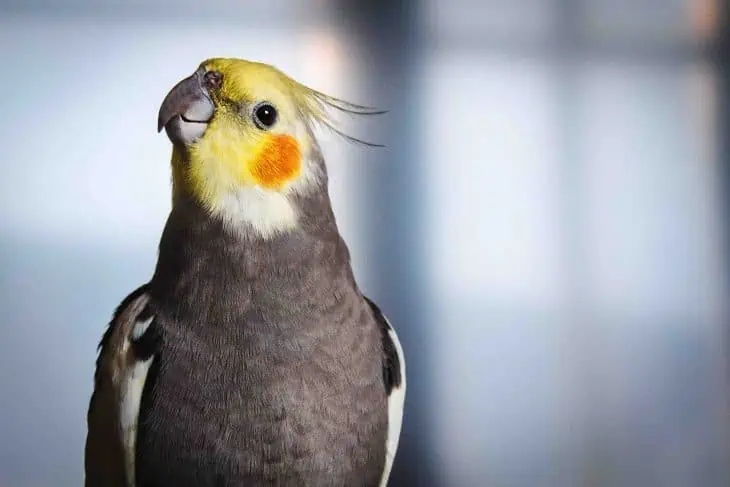
Cockatiels originated in Australia. They are intelligent, friendly, and easy to take care of. Currently, they are one of the most popular pet birds in the United States. The cockatiel is a small parrot that has a crest, different patterns of color, and the skill to mimic the sounds and words that they hear. With practice, cockatiels can sing fluently! Out of all the cockatiel facts, this might be one of the major reasons why people want to have them as pets.
Who wouldn’t want to wake up to the wonderful singing of a bird? Nothing lifts the spirits in the morning more than a chorus of birds singing their hearts out. If you want this to happen, though, you need to give your cockatiel a bit of training. First, you need to whistle a few tunes to your cockatiel. These should be tunes you know. Next, play a song from a speaker near the cage of your cockatiel every single day. In the beginning, choose an instrumental song with a simple tune. For a cockatiel that has never sung before, playing a song with a sophisticated melody will simply confuse it.
After spending time with them, don’t be surprised if they become clingy. Some cockatiels get so attached to their owners, they scream when they miss them. Don’t be afraid when that happens, it’s just how they show affection. So, if you are looking for a lifetime pet, a cockatiel is a great choice. The average longevity of a cockatiel in captivity is 16 to 25 years. Enough diet, exercise, and human interaction will make them live longer. Be good to them, and they will be good to you!
Now, let’s know more about their uniqueness with these 40 enjoyable and engrossing cockatiel facts!
- Around the world there are about 22 color mutations of cockatiels.
- In captivity, cockatiel can live from 16 to 25 years.
- In the wild, cockatiels can fly for about 48 kilometers per day with a speed of 64 kilometers per hour.
- The adult size of the cockatiel measures around 12 to 13 inches (30.48 to 76 centimeters).
- Cockatiel weighs approximately 2 to 4 ounces (56 to 113 grams).
- The cockatiel is also known as the quarrion or weiro bird.
- The cockatiel is one of the most famous household birds.
- It is native to Australia.
- Initially, the cockatiel is considered a crested parakeet or small cockatoo.
- Based on its recent molecular studies, Cockatiel now belongs to its own subfamily, Nymphicinae.
- Cockatiels have long tails about half of their total length.
- Cockatiels have heavy beaks they use to crack nuts.
- Cockatiel’s scientific name is Nymphicus hollandicus.
- It has a yellow head and red patches on its ears.
- They are one of the most popular birds.
- Cockatiel got its name from the term,“kakatielje,” meaning a little “cockatoo,” in Dutch.
- Cockatiel can acknowledge the voice of their owners and easily respond to them.
- They enjoy looking at their reflection in the mirror.
- Cockatiels love music and they sometimes dance with it.
- When a cockatiel’s mate dies, it may eat very little or may even stop eating because of loneliness.
Cockatiels use their crest to express their emotions.
Cockatiels express their moods through their crest, (a tuft of feathers or fur). It is slightly tilted when they are relaxed; if they are angry, it is flattened close to the head; when flirtatious or alluring, the crest is held flat, but projected outward in the back. Lastly, it is upright, if excited or startled; and halfway upward, when they are tired.
They started with a normal grey color.
The normal grey cockatiel is the original color of the cockatiel. Eventually, orange cheek patches were seen in cockatiels. In the 1850s, color mutation began with the first captive cockatiels in France. It took 100 years before the mutation occurred. Mutations happen due to specific breeding.
Pied cockatiel was the first color mutation.
The first cockatiel color mutation (recorded in the United States) were the pied cockatiels in 1951. They were an offshoot of a mutation of the normal gray cockatiel, or the wild type bred, based in San Diego, California. They have gray to light yellow and white feathers with orange patches on their cheeks. Pied cockatiels make good pets because of their comical, friendly, and curious behavior.
Lutino cockatiel has unique colors.
Lutino cockatiels are sometimes yellow or white, with orange patches on their cheeks, and a yellow mane and head. Their young have red eyes which darken as they grow. Typically, Lutino cockatiels measure around 12 to 13 inches or 30 to 33 centimeters in length, and weigh between 3 and 4.4 ounces or 85 to 125 grams.
Pearl cockatiels have a pearl-like arrangement of colors.
The 3rd color mutation to be established were found in the pearl cockatiels. They appeared in Germany in 1967 or 1968. Pearl cockatiels have a pearl-like arrangement of white or yellow feathers on their nape, back, and wings, while their tails are yellow with black and yellow design. Their young or chicks have light color eyes, these eyes darken as they mature.
White-faced cockatiels have no orange patches on their cheeks.
The white-faced cockatiel first appeared in Holland in 1964. It was the 7th color mutation of the bird. They do not have yellow coloring at all, and orange patches on their cheeks. The male white-faced cockatiels have white faces, while the females contain a but of greyish coloration and have alternate bands of color under their tail feathers.
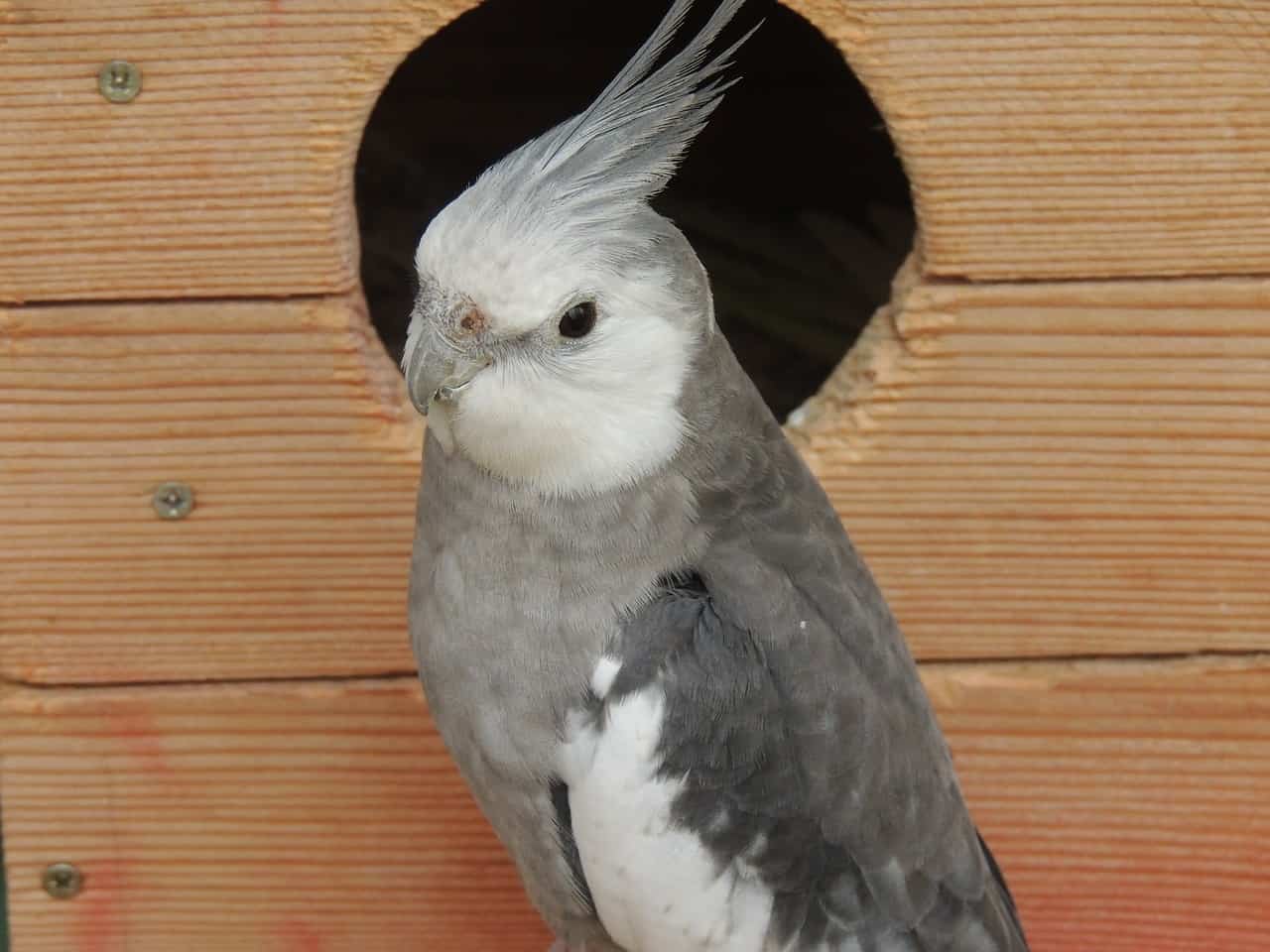
The albino cockatiel is a crossbreed between lutino and white-faced cockatiels.
The Albino cockatiel is not a color mutation but a hybrid between a lutino and a white-faced cockatiel. They have completely white feathers, feet, and toenails, but their eyes are bright red, just like Lutino cockatiels.
Cockatiels eat a variety of food.
In the wild, cockatiels consume a variety of seeds, fruits, and berries. They usually raid the crops of farmers.
Meanwhile, in captivity, they feed on pellets and other fresh vegetables and fruits like bananas, oranges, broccoli, carrots, lettuces, and peas. Generally, cockatiels consume about a tablespoon of food per day. They should not be given avocado, chocolate, and salt as these are toxic to them.
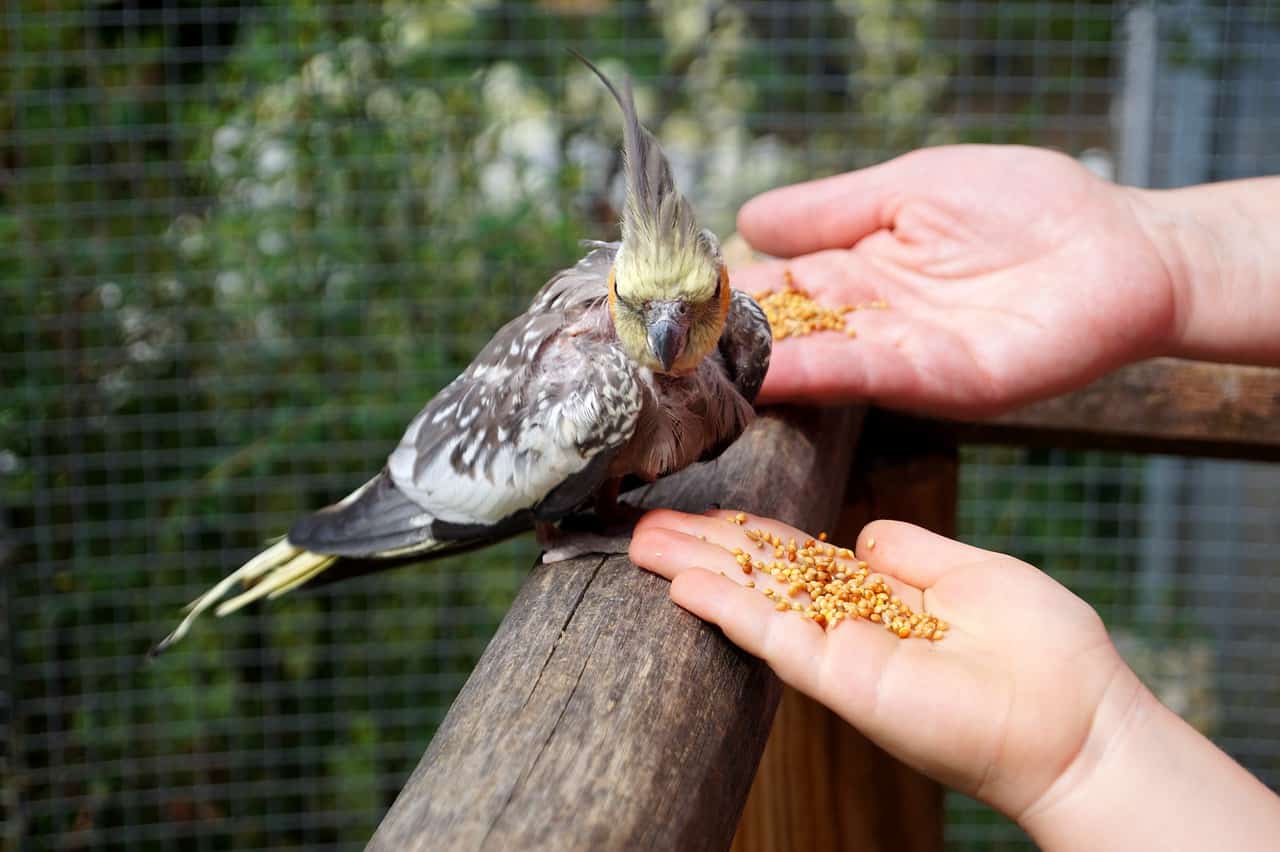
Cockatiels breed during the spring season.
The natural mating season of cockatiels in the wild is from spring to early autumn. During breeding season, they need warmer temperature, plenty of food and rainfall, and more hours of natural daylight. Although cockatiels are somewhat ready to reproduce when they reach 9 to 12 months old, it’s important to take note that they reach their full sexual maturity at 15 to 24 months.
Cockatiels lay eggs every other day.
Cockatiels usually make their nest in a eucalyptus tree and near a source of fresh water. Within three weeks of mating, female cockatiels lay their eggs, one every other day, and 4 to 6 eggs in one clutch or batch, which she hatches for 17 to 23 days.
Baby cockatiels are called hatchlings.
After 5 weeks of incubation, baby cockatiels or hatchlings emerge. Their skin is light pink, their eyes are still closed, and the beaks are also pale, just like their skin. Hatchlings are about an inch long, and are usually still weak to stand. Their parents take turns in keeping them warm and well-fed. In about six to eight weeks, baby cockatiels will become fully grown and can live on their own.
Cinnamon cockatiel has a pale brownish color.
Cinnamon cockatiel, also known as Isabelle Cockatiel or the Cinnamon Tiel, has a unique color caused by a recessive gene. The gene affects the melanin pigment from changing into black or grey, which is a common color for cockatiels. Cinnamon cockatiels’ eyes, beaks, feet, legs, and feathers are all brown.
Cockatiels learn different tricks.
Just like other birds, cockatiels can be taught several tricks like handshakes, flips, high five, turn around, and fly on command. It may take months before the cockatiels learn a trick. So patience and repetition are important in teaching them.
Cockatiels make different sounds.
Cockatiels make different contact calls or alarm calls. They make loud chirps that continue when something startles them; the sound of beak grinding means they are happy and relaxed. They hiss when they are threatened or don’t want to interact with other people.
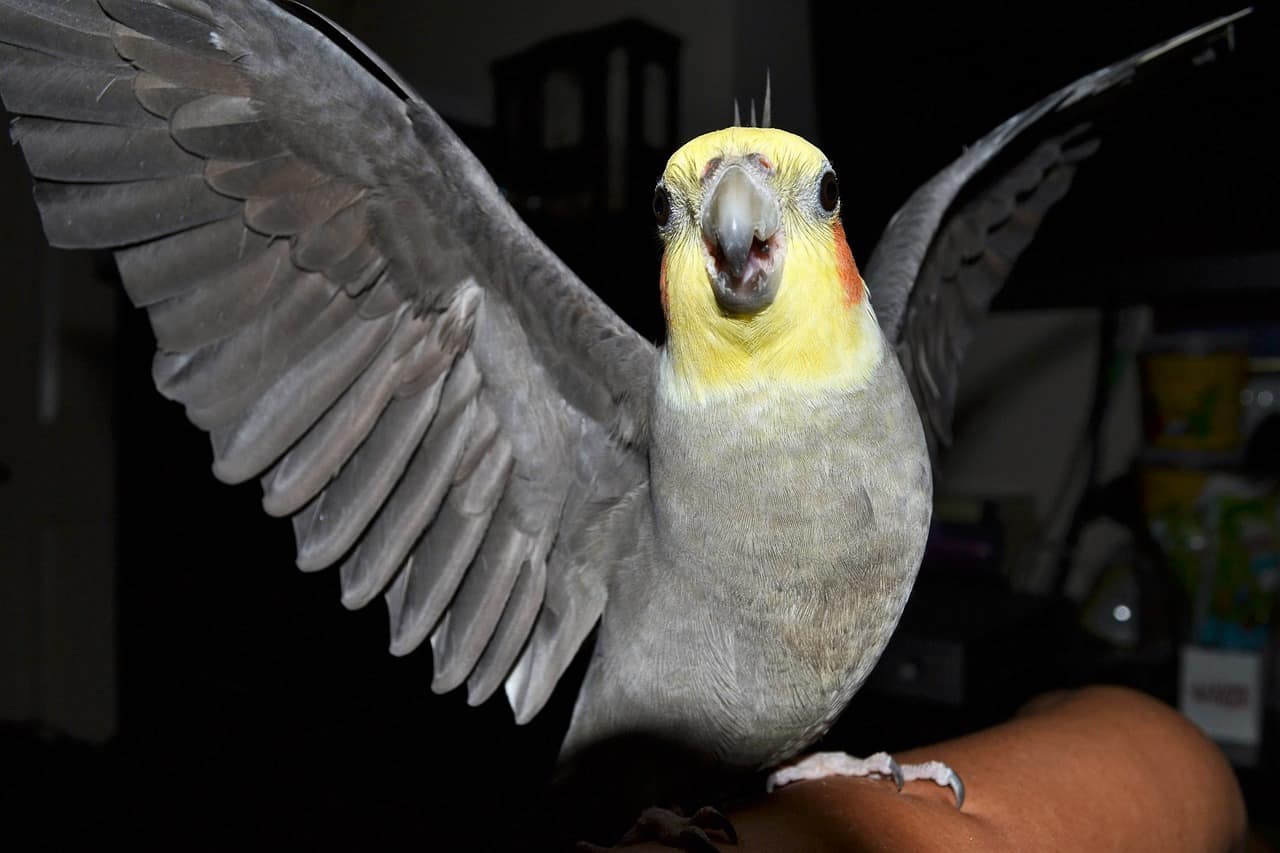
Cockatiels are capable of talking.
Cockatiels, like most parrots, are capable of talking. They can be taught some words or phrases like, “Hello,” “I am a good bird,” and “Pretty bird.” Furthermore, male cockatiels are more likely to learn how to say words than females. The key for cockatiels to talk is to repeat the phrase or word, let them master it before teaching another.
Cockatiels are monogamous.
Sweet cockatiel facts! Cockatiels are one of the birds that mate for life. In the wild, they select their partners, and usually live together. Those in captivity will choose a mate if they’re in the same shop or the owner can give them partners. Cockatiels show their love and loyalty to their mates as they remain together.
Cockatiels need a big cage.
It is essential for cockatiels to have a spacious cage that should be at least 24 inches tall (60.96 centimeters), 24 inches wide, and 24 inches deep. Similarly, the space between the cage bars should not be more than 3/4 inches, so they don’t stick out their heads. Moreso, since cockatiels have strong beaks, the cage must be sturdy to prevent them from escaping and must have at least 3 to 4 perches where cockatiels can sit on.
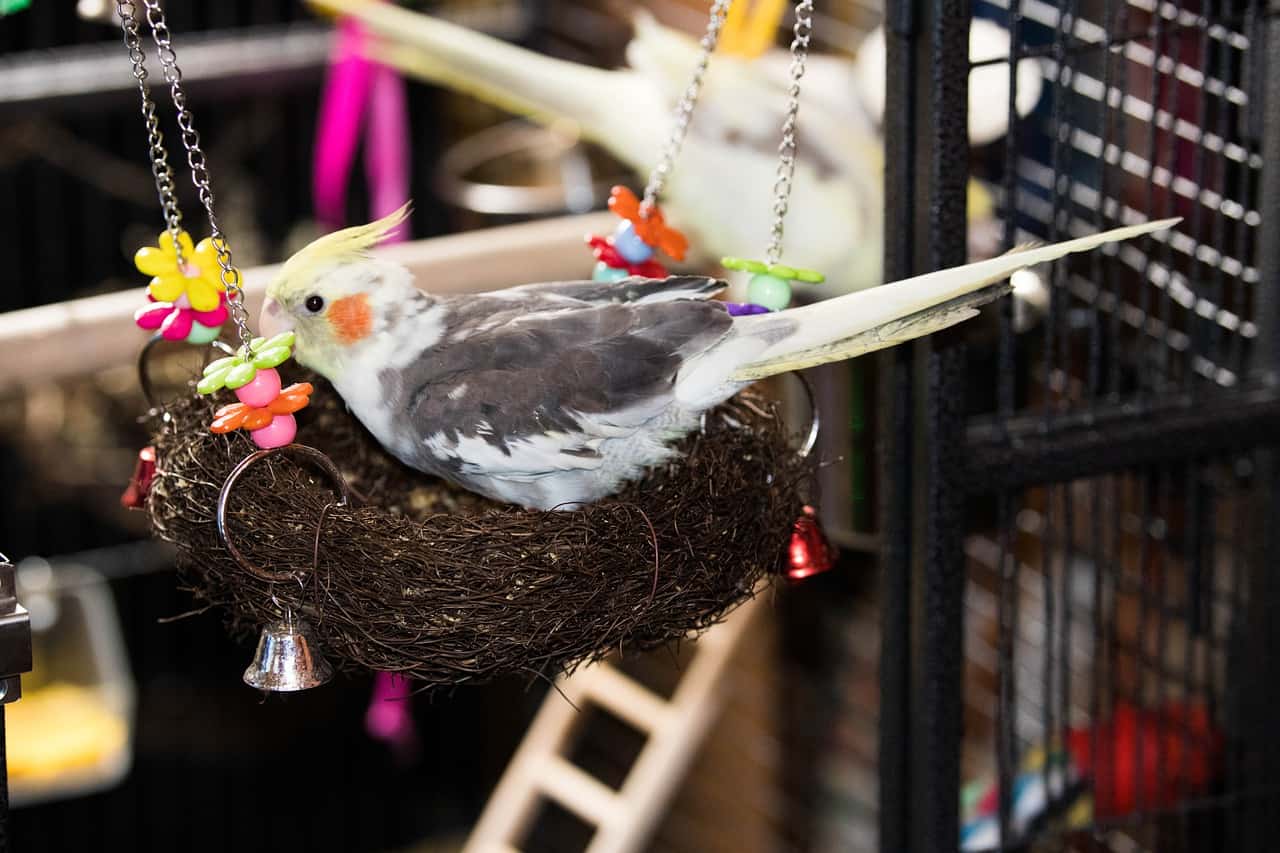
Cockatiels are prone to different illnesses.
Nutritional deficiency is one of the most common health issues that affect cockatiels. This is because, most of the time, they only eat seeds. Cockatiels are also prone to fatty liver because of rich in fat and carbohydrate diets. Plus, they have limited or no exercise. They are also vulnerable to respiratory diseases and psittacosis or parrot fever.
The fumes of Teflon and other non-stick pans are harmful to cockatiels.
According to research, the smell of Teflon and other non-stick pans when heated are highly harmful to cockatiels. The fumes of non-stick pans may cause respiratory infection and might lead to death. In fact, metal or steel pans are safer if you have cockatiels or birds in your house.
A cockatiel's price ranges from $110 to $300.
Cockatiels have different price ranges and some are less expensive than others. A normal grey cockatiel is around $150; a Lutino cockatiel may cost you $150 to 250; a pied cockatiel costs $110 to $170; a cinnamon cockatiel ranges from $130 to 160, while the white cockatiel is about $200-$300.
Was this page helpful?
Our commitment to delivering trustworthy and engaging content is at the heart of what we do. Each fact on our site is contributed by real users like you, bringing a wealth of diverse insights and information. To ensure the highest standards of accuracy and reliability, our dedicated editors meticulously review each submission. This process guarantees that the facts we share are not only fascinating but also credible. Trust in our commitment to quality and authenticity as you explore and learn with us.
